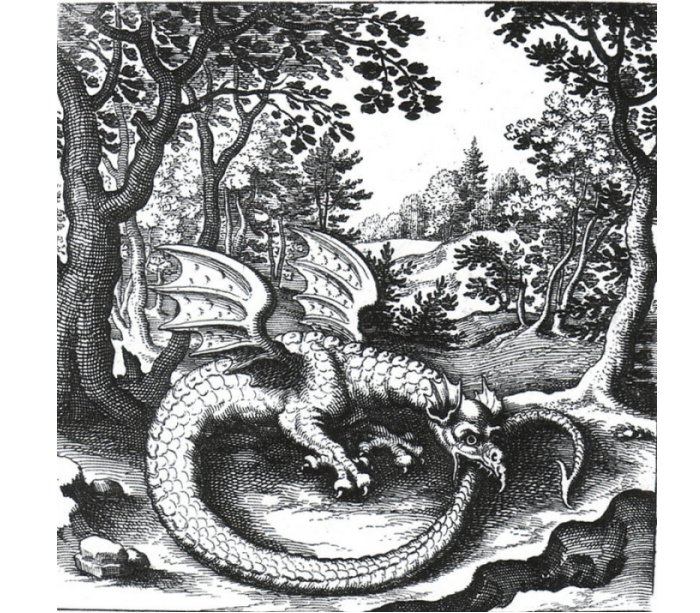Ouroboros – Cosmic Serpent And The Self-Devourer – Universal, Powerful Symbol Of Great Antiquity
A. Sutherland - AncientPages.com - Widely known in many religions worldwide from Europe, Asia, and Africa, this mystical, very old symbol means "the end is the beginning." It has the ability to reproduce itself. It mates, impregnates, and destroys itself, and all this happens in the cycle of time.
An ouroboros in a 1478 drawing in an alchemical tract. Anonymous medieval illuminator. Image credit: uploader Carlos adanero - Public Domain
Artifacts in the form of bracelets with this symbol are found in areas occupied by the Slavs beginning with the first European Neolithic cultures. The ancient Greeks considered Ouroboros a serpent or a worm engulfing its tail and forming a circle with the beginning and the end.
The same was also an interpretation of the symbol in other cultures because Ouroboros' means always the same: an eternal cyclic force – both destructive and at the same time, crucial as a part of nature's process of regeneration.
Cosmic cycle - wheel appears half as light and half as darkness; in this form, it is Yang and Yin. Ouroboros means 'life conflict' when life passes and death comes. Still, the end also means the beginning.
It is also a union of opposites, Heaven and Earth working together and consistently in harmony.
Ancient engravings of Ouroboros, dated to the Chou dynasty in China (1200 BC), symbolize the continuity of life with the dragon biting his tail and in a mythical monster called the Midgard serpent—also known as Jormungand, encircled the world, biting its tail.
Engraving of a wyvern-type ouroboros by Lucas Jennis, in the 1625 alchemical tract De Lapide Philosophico. The figure serves as a symbol for Mercury. source
The circle is also a symbol of perfection like the halo that is drawn over the heads of the Byzantine images of the saints—believed to be inspired by the Milky Way and described in ancient writings as a luminous serpent (serpent of light) that dwells in high heavens. Ouroboros is associated with Hermetism alchemy. It speaks of purity, wholeness, and infinity. Gnostic belief "passes through all things" as the symbol of the inseparable, the "unchanging law" that applies to all things and connects between them.
Generally, the symbol's meaning remains the same – eternal cyclic force is both destructive and regenerative.
Hermes - the god of alchemy - defines the Ouroboros as: "Serpens cuius caudam devorabit, "a snake that devours its own tail, symbolizes the alchemical Mercury represents the cosmic unity and the circular nature of the work of the alchemist.
Ouroboros, which symbolizes the cyclical nature of the universe and a path to the sun, was already known to ancient Egyptians around 1600 BC. Still, it is likely to be even much older than this.
From there, knowledge about Ouroboros moved to the Phoenicians and to the Greeks and took a distinguished place in myths of Vikings (Norse,) Hindus, tribes of Central America, West Africa, Voodoo beliefs,
The Ouroboros concept appears elsewhere.
Updated on March 7, 2024
Written by – A. Sutherland AncientPages.com Staff Writer
Copyright © AncientPages.com All rights reserved. This material may not be published, broadcast, rewritten or redistributed in whole or part without the express written permission of AncientPages.com
Expand for referencesMore From Ancient Pages
-
 Mystery Of The Lost Continent Destroyed By An Ancient Cataclysm – Wars Between The ‘Yellow Men And Black’ Men – Part 1
Ancient Mysteries | Aug 10, 2021
Mystery Of The Lost Continent Destroyed By An Ancient Cataclysm – Wars Between The ‘Yellow Men And Black’ Men – Part 1
Ancient Mysteries | Aug 10, 2021 -
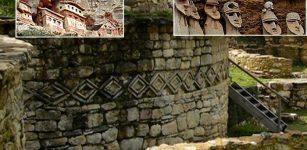 Mysterious Chachapoyas ‘Warriors Of The Clouds’ And Their Impressive Structures
Civilizations | Nov 4, 2020
Mysterious Chachapoyas ‘Warriors Of The Clouds’ And Their Impressive Structures
Civilizations | Nov 4, 2020 -
 On This Day In History: Unbelievable Flight Took Place – On Apr 28, 1939
News | Apr 28, 2016
On This Day In History: Unbelievable Flight Took Place – On Apr 28, 1939
News | Apr 28, 2016 -
 5 Fascinating Sacred And Lost Places In Myths And Legends
Featured Stories | May 31, 2016
5 Fascinating Sacred And Lost Places In Myths And Legends
Featured Stories | May 31, 2016 -
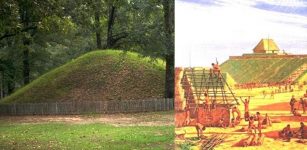 Secrets Of Ancient Mound Builders In Louisiana Revealed
Archaeology | May 23, 2018
Secrets Of Ancient Mound Builders In Louisiana Revealed
Archaeology | May 23, 2018 -
 Mysterious Ancient Spiral Structure And Buried Towers Discovered At Angkor Wat
Archaeology | Dec 9, 2015
Mysterious Ancient Spiral Structure And Buried Towers Discovered At Angkor Wat
Archaeology | Dec 9, 2015 -
 Mystery Of The 2,000-Year-Old ‘Urn Burial’ Ceremonies: 113 Tombs Discovered Near the Ancient City Of Fudi
Archaeology | Oct 11, 2016
Mystery Of The 2,000-Year-Old ‘Urn Burial’ Ceremonies: 113 Tombs Discovered Near the Ancient City Of Fudi
Archaeology | Oct 11, 2016 -
 Perforated Shells Were Used By Humans 120,000 Years Ago
Archaeology | Jul 10, 2020
Perforated Shells Were Used By Humans 120,000 Years Ago
Archaeology | Jul 10, 2020 -
 Evolution Of Paleodiet At Neolithic Qujialing Site Unveiled By Scientists
Archaeology | Nov 30, 2022
Evolution Of Paleodiet At Neolithic Qujialing Site Unveiled By Scientists
Archaeology | Nov 30, 2022 -
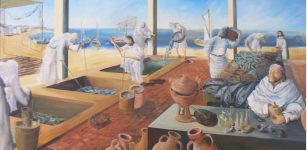 Mediterranean Hunter-Gatherers Relied On Marine Resources More Than Previously Thought
Archaeology | Feb 22, 2023
Mediterranean Hunter-Gatherers Relied On Marine Resources More Than Previously Thought
Archaeology | Feb 22, 2023 -
 Melusine: Charming Water Fairy In European Legend About Taboo And Broken Promise
Featured Stories | Jan 2, 2019
Melusine: Charming Water Fairy In European Legend About Taboo And Broken Promise
Featured Stories | Jan 2, 2019 -
 On This Day In History: Treaty Of Seville Signed – On Nov 9, 1729
News | Nov 9, 2016
On This Day In History: Treaty Of Seville Signed – On Nov 9, 1729
News | Nov 9, 2016 -
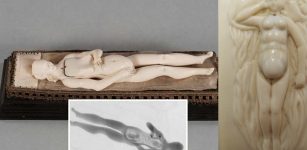 Secrets Of Ancient Ivory Manikins Revealed
Archaeology | Nov 28, 2019
Secrets Of Ancient Ivory Manikins Revealed
Archaeology | Nov 28, 2019 -
 Mystery Of The Lost Cahuenga Pass Treasure: Baffling Unexpected Deaths Caused By A Curse Or Natural Causes?
Featured Stories | Nov 2, 2018
Mystery Of The Lost Cahuenga Pass Treasure: Baffling Unexpected Deaths Caused By A Curse Or Natural Causes?
Featured Stories | Nov 2, 2018 -
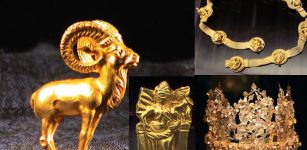 Priceless Artifacts From The Bactrian Hoard Are Missing – Where Are They?
Artifacts | Apr 3, 2022
Priceless Artifacts From The Bactrian Hoard Are Missing – Where Are They?
Artifacts | Apr 3, 2022 -
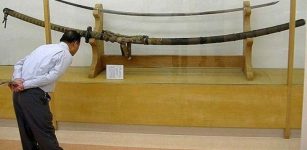 The Norimitsu Odachi – Giant Japanese Sword Remains An Enigma
Artifacts | Mar 22, 2019
The Norimitsu Odachi – Giant Japanese Sword Remains An Enigma
Artifacts | Mar 22, 2019 -
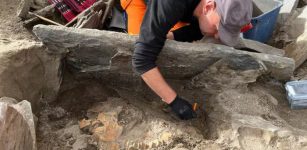 ‘Sensational’ Discovery Of Large Untouched 4,000-Year-Old Grave In Norway
Archaeology | Nov 10, 2023
‘Sensational’ Discovery Of Large Untouched 4,000-Year-Old Grave In Norway
Archaeology | Nov 10, 2023 -
 Ancient DNA Reveals A Diverse Community Lived At Machu Picchu, The ‘Lost City Of The Incas’
Archaeology | Jul 26, 2023
Ancient DNA Reveals A Diverse Community Lived At Machu Picchu, The ‘Lost City Of The Incas’
Archaeology | Jul 26, 2023 -
 Huangluo: Long-Hair Village Where Women Don’t Cut Their Hair – A 2,000-Year-Old Tradition Of The Yao People
Ancient Traditions And Customs | Jun 18, 2017
Huangluo: Long-Hair Village Where Women Don’t Cut Their Hair – A 2,000-Year-Old Tradition Of The Yao People
Ancient Traditions And Customs | Jun 18, 2017 -
 Agriculture In North America Led To Changes In Age-Independent Mortality
Archaeology | Jan 24, 2023
Agriculture In North America Led To Changes In Age-Independent Mortality
Archaeology | Jan 24, 2023


